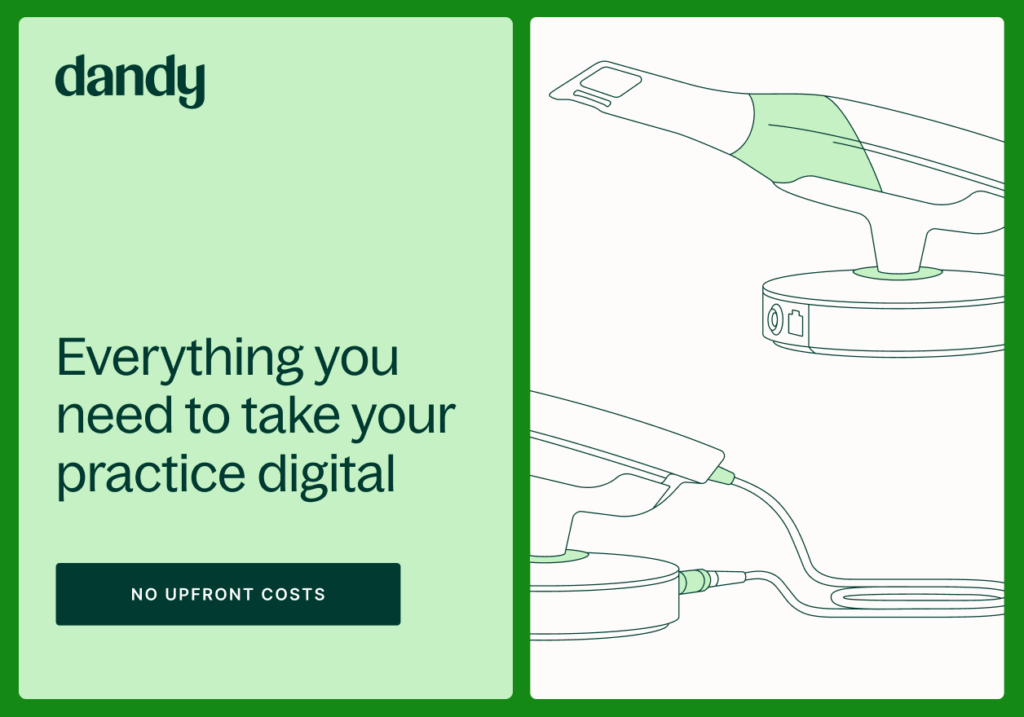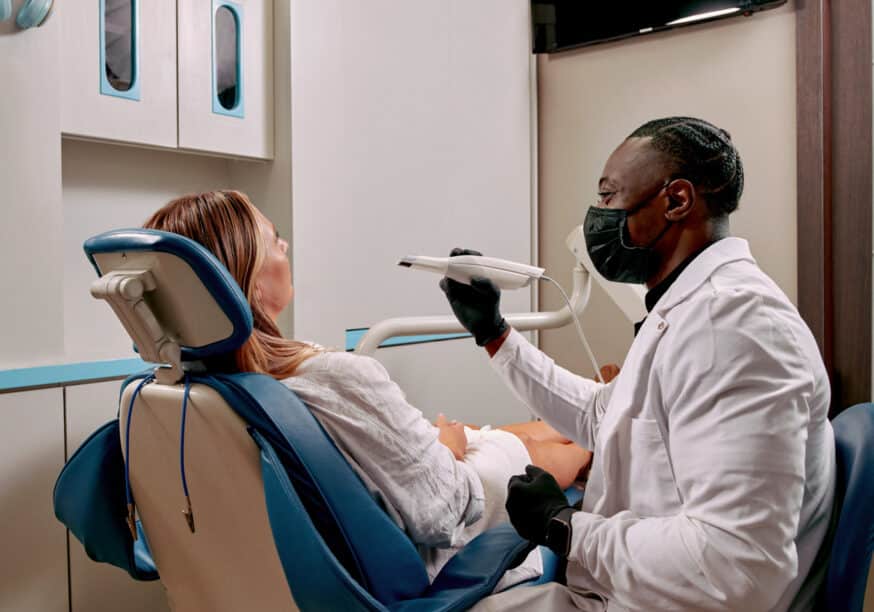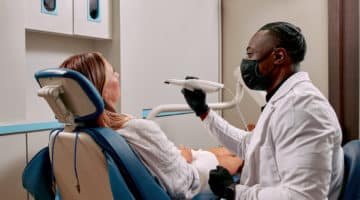Futurist and author Arthur C. Clarke famously said, “Any sufficiently advanced technology is indistinguishable from magic.” Just as technological progress has vaulted the entertainment, transportation, and medical fields to previously unimaginable frontiers, dental tech has taken its own remarkable strides. Digital dental impressions may seem like sci-fi wizardry, but they’re real, they’re mind-blowing, and they’re the key to unlocking your practice’s future.
And lest you think digital impressions are just bells and whistles, an apt analogy would be comparing a coal-power locomotive to a mag-lev bullet train; both accomplish essentially the same task, but there is no question which is superior. And let us be clear: besides adding a ‘wow’ factor, adopting digital dental impressions can and will have positive dollars-and-cents effects on your business, improving your practice’s efficiency, competitiveness, amenity, cost, and precision. Still skeptical? Well, we have the receipts to prove it.
“[Patients are] used to the old-fashioned impression material. Nobody likes that stuff because it’s dirty and messy. When patients see the scanner, … every patient is impressed. It’s the ‘wow’ factor.”
Dr. Angela Leung, The Endodontics Implant Center
In today’s complex market landscape, dental practices are challenged by rising costs, labor shortages, and insurance billing – among other things. Small practice owners are looking for ways to offset these issues and stay competitive. One way to do so is to expand into high-growth specialty services like orthodontics and endodontics. Embracing digital technology like an intraoral scanner will help you prepare for these new growth opportunities.
So below, we’ve outlined the top 5 reasons that digital impressions with an intraoral scanner will push your practice into the technological vanguard, helping keep your business growing well into the 21st century.
What is a digital dental impression?
By utilizing digital dental technology, we can generate 3D images of a patient’s teeth and gums using a handheld wand known as an intraoral scanner or digital impression scanner. Once this simple process is complete, the images are sent to the dental lab immediately, where the tooth restoration tools can start being made.
Compared to traditional impressions, digital impressions are a lot less invasive. They also take less time to administer—typically just one to two minutes in total. Compared to intrusive and potentially inaccurate methods, digital dental impressions are faster, more efficient, more accurate, and more comfortable for your patient–a factor that, data tells us, increases their overall satisfaction and makes them more likely to recommend your practice. So how does this remarkable technology work and what are its practical applications?
A handheld device called an intraoral scanner is inserted into the patient’s mouth. In just one to two minutes, the scanner records the size and shape of the mouth including each tooth as well as the gums, bite, and hard and soft palates. This data is automatically converted into a detailed 3D rendering available–near-instantaneously–for viewing on a nearby monitor. This model can then be inspected from any distance or angle, removing the need for abstract descriptions and generic replicas. Data shows that patients have an overwhelmingly positive reaction to this process and the understanding it facilitates (Data can be found on page 25 of the 2023 Dandy Dental Survey).
But digital dental impressions are much more than an awe-inspiring visual aid. With the push of a button, your patient’s data can be sent directly to a lab where skilled technicians and dental professionals use computer-aided design and computer-aided manufacturing (CAD/CAM) to ensure proper alignment and spacing before using precision tools to fabricate the crown, prosthesis, overlay, or any other intraoral appliance. No curing, no air-pockets, and virtually no room for error.
5 advantages of digital dental impressions
1. Digital technology gives dentists a competitive edge
In our 2023 Dandy Dental Survey of 600 dental patients’ priorities, just 27% of respondents reported the use of an intraoral scanner. That leaves almost ¾ of all patients surveyed who have not experienced this incredible tech. Why does this matter? That same survey showed an overwhelmingly positive response to those practitioners who did use a digital scanner, with the use of digital dental impressions seeing a 46% correlation with patients’ highest possible overall satisfaction ratings. Add to this the fact that patients who visited practices using an intraoral scanner are 12% more likely to recommend said practice, and a clear picture forms: if patients have a choice of where to go, they’re much more likely to be happy with–and therefore recommend–a practice that utilizes digital impressions.If that’s not enough to convince you that adoption of an intraoral scanner will make you stand out from the competition, our data shows that patients are much more likely to switch dentists due to long wait-times and low transparency about the processes they undergo–digital impressions both reduce time in the chair and create an engaging visual model to which practitioners can refer. And when data shows the overwhelming importance of a dental practice’s online presence, reports of patients excitedly taking photos of their 3D digital impression for posting on their socials translates to a real competitive edge.
2. Digital impressions improve your patients’ experience
Happy dental patients can mean many things: less stress, higher case acceptance, and–perhaps most importantly–more patient referrals. Dr. Angela Leung of San Francisco’s Endodontics Implant Center said: “When patients see the scanner… every patient is impressed. It’s the ‘wow’ factor.” And Dr. Leung is far from alone.
Dr. Layla Baidas, owner of the successful Illinois practice, Signature Smiles of Park Ridge, has observed the same reactions in her patients. “The first impression when I scan a patient’s teeth is, ‘What is this? This is amazing!’ They are impressed with the technology and love seeing their teeth. And it’s a lot faster [than traditional impressions], so patients love it.”
Dr. Delaney Spaulding of boutique practice, Ross Bridge Dentistry in Hoover, Alabama tells us that, because intraoral scanning is so overwhelmingly impressive, quick, and easy, she’s begun using it as a standard part of every patient’s visit as part of an overall wellness scan. “Any change [our practice makes] is a small tweak and it’s a small tweak in a positive direction,” Dr. Spaulding explains. “[Patients] are already blown away by our technology and now adding the wellness scan–it’s a small tweak that increases how amazing their visit is.” And, as mentioned earlier, versus the gag-inducing traditional molds, an intraoral scanner uses light and takes mere minutes to complete; anybody who has ever endured a PVS mold can attest: a quick, easy alternative for getting into and out of the chair is a no-brainer.
3. Digital workflows make your job easier
In a clinical study comparing intraoral scanning and conventional impressions, the vast majority of practitioners preferred the digital scanning technique (89%) over the conventional impression technique (11%). This could be owed to a number of factors, all of which translate to: digital impressions are just plain easier. No more mixing compounds, filling trays, cleanly releasing the molds, inspecting them for imperfections or air bubbles–with digital impressions, the scanner goes into the patient’s mouth, a few buttons are clicked, and the machine takes care of the rest. And all of this would be great if it alone saved you effort, but perhaps most importantly, digital dental impressions are far more accurate than PVS dental impressions. In fact, practitioners who go digital enjoy a staggering 89% reduction in impression errors overall, saving the time and hassle associated with shipping pieces back, adjustments, or dreaded remakes.
Dr. Barry Bartusiak of successful crown-and-bridge practice, Bartusiak Dental Care of Washington, in Pennsylvania can attest to the ease of digitally-derived appliances. He tells us that, as opposed to those from PVS dental impressions, appliances derived from digital scans rarely have any issues or need any adjustments at all–they tend to just work. “The fit and quality–the crowns and bridges [made from digital scans] are superior to the traditional way,” he says, definitively. Dr. Bartusiak tell us that the scanning process can begin almost immediately when the patient sits down, and the fabrication process can start before a patient has even left the office, done and done. “Are you kidding me?” Dr. Bartusiak exclaims when asked if digital impressions take less time to arrive in his hands. “I get my [fabricated appliance] back in like, seven to ten days–it doesn’t take a month.”
Related
- What is Digital Dentistry?
- Trends in Dentistry: 5 Crucial Takeaways You Can Actually Use
- The Top 5 Benefits of a Digital Workflow for Dentistry According To Real Dentists
4. Increase productivity with digital impressions and workflows
An aspect of digital impressions we have touched on, but not explicitly said until now, is the massive benefit of digital impressions and digital workflows to your practice’s overall productivity.
It almost goes without saying that, when you have a busy day and a full plate, not having to fiddle with compounds, or carefully release/inspect a mold allows you to keep your attention on what matters.
Since intraoral scanners are so advanced, so straightforward, and so accurate all on their own, operation is virtually fool-proof–any member of your practice staff can easily take digital impressions. This means a new hire can begin taking digital impressions on day-one, a team member with minimal training can help jump-start a visit, and an assistant can confidently take initiative. “[Digital impressions free] up my time since my assistant can do the scanning,” explains Dr. Leung whose thriving business relies heavily on implants’ accuracy and precision fabrication. By allowing others in her practice to take this task of her plate, Dr. Leung explains, “I can do more procedures and increase my productivity.”In addition, digital workflows help keep focus oriented on what matters. Digital workflows mean your patients’ data stays organized and readily accessible, facilitation lightning-quick communication between parties. This places vital information at your staff’s fingertips–no more digging through messy folders, rooting through cumbersome filing cabinets, deciphering spotty faxes, buying postage, insurance, or packing peanuts. Plus, digital data transfer means your office will no longer have to abide by shipping companies’ limitations or liabilities–your patients’ data can travel instantaneously, directly, securely with just a few clicks.
5. Digital impressions help reduce costs
In Dandy’s 2022 Dental Industry Report–a survey of dental professionals–it was found that a majority of respondents cited increasing costs as both an acute priority and challenge. By adopting digital dental impressions, you can begin to realize tangible savings on day-one, helping you address this stubborn, high-priority issue.
Digital impressions mean a complete reduction of impression materials–no more paying for compounds, replacing expired stock, or carving out office space the store them. You know better than anyone the value of square footage; every inch of your office well-utilized equals a dollar well-spent.
Without the cost associated with the back-and-forth of shipping molds, your office saves on everything from bubble wrap to postage, reducing your office’s budget for these materials overnight.
If time is money, every minute your patient is in the chair represents real value for your business. With this in mind, as mentioned earlier, adoption of digital impressions means an 89% reduction in appliance remakes–a massive reduction in additional (usually unbilled) fitting appointments. You can also enjoy a near-total removal of the scheduling and rescheduling associated with refitting or adjusting restorations. And gone are losses of valuable time due to delayed shipping, limited delivery windows, or any other SNAFU arising from courriers.
Finally, as the 2023 Dandy Dental Survey has shown, a satisfied customer is a return customer, and a return customer is a potential recommendation, and a recommendation or review online is a great piece of free advertising all on its own–your happy customers and good work can in themselves help drive customers to your business.
Digital impressions in the dental industry
Digital impressions are becoming more popular among dentists and patients alike, and for good reason. With the overwhelming betterment of the patient experience, reduction in overhead costs from office to treatment, and overall efficiency in process, digital dental impressions are earning their popularity.In summation, adoption of digital dental impressions using an oral scanner are virtually all upside. So what is the largest barrier to entry for most practices? The initial outlay, that is, cost. Intraoral scanners are an a cutting-edge technology and, like the newest smartphone or electric vehicle, can induce some sticker shock. But an investment in this incredible technology is an investment in your practice’s future and, luckily, when dentists partner with Dandy—the first and only Digital Dental Lab—we will help get you up and running by supplying your practice with a free best-in-class 3Shape TRIOS intraoral scanner.
Learn more and get started on your future, today!




